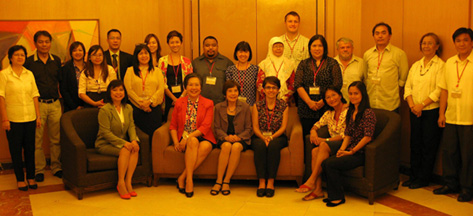
Doing its part to help reduce the impact of Harmful Algal Blooms (HAB) or red tide throughout the Asia-Pacific region, the Philippine Nuclear Research Institute – Department of Science and Technology (PNRI–DOST) hosted the first coordination meeting of the International Atomic Energy Agency (IAEA) RAS7026 Project, “Supporting the Use of Receptor Binding Assay (RBA) to Reduce the Adverse Impacts of Harmful Algal Toxins on Seafood Safety” at Eastwood Richmonde Hotel in Quezon City from June 23 to 27.
The meeting was attended by 17 participants from Indonesia, Malaysia, the Philippines, Thailand and the Marshall Islands with experts from Institut Louis Malarde (ILM), French Polynesia; Cawthron Institute, New Zealand; and the Intergovernmental Oceanographic Commission of the United Nations Educational, Scientific and Cultural Organization (IOC–UNESCO), Denmark. The IAEA which organized the meeting was represented by Dr. Jane Gerardo Abaya, Section Head for the Technical Cooperation Department in Asia and the Pacific and Programme Management Officer, and Ms. Marie Yasmine Bottein, IAEA Technical Officer. Local participants included scientists, researchers and regulators from the University of the Philippines–Marine Science Institute (UP–MSI), the Bureau of Fisheries and Aquatic Resources (BFAR) and PNRI.
The meeting assessed the technical gaps and constraints for each nation’s marine environment monitoring programs on red tide and the possible cooperative solutions to these problems. Sampling protocols for toxins and strategies to enhance public awareness on the use and acceptance of the RBA as a regulatory tool were among the focus of the discussions.
On the last day, the IAEA experts visited the PNRI Chemistry Research Section HAB laboratories. The institute serves as the IAEA Collaborating Center for the project.
The Philippines is one of the member states participating in the regional project to promote the radioligand RBA technology for the detection and quantification of HAB toxins in mussels and other shellfishes which prove damaging to the health and business of fishing communities and consumers alike.
“The project starts with a noble purpose which will ultimately benefit our fisher folk and the public at large. It is also very relevant as the HAB problem has not gone away, but has spread to new areas in the Philippines,” said PNRI Director Dr. Alumanda Dela Rosa in her welcome address.
The RBA method uses membrane receptors prepared from rat brain which react to the toxins extracted from the shellfish. It was adopted by the Association of Official Analytical Chemists (AOAC) in 2011 as the official method for detecting paralytic shellfish poisoning (PSP).
In the Philippines, PNRI collaborates with the UP-MSI and BFAR in developing a field detection system and in transferring the RBA technology to the regulatory authorities.












































